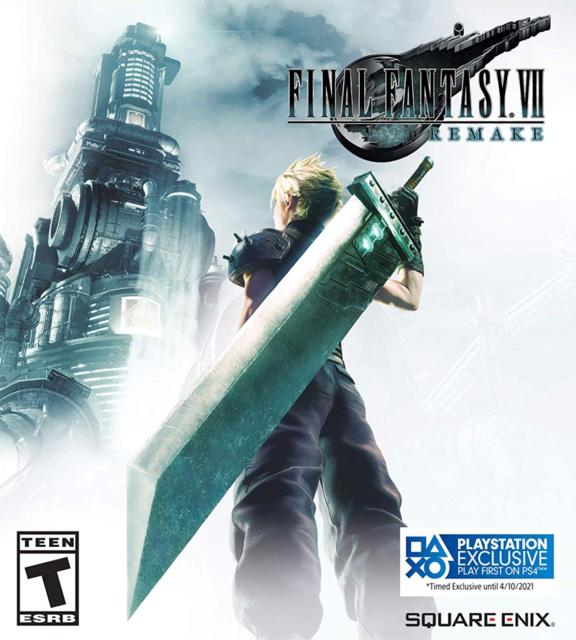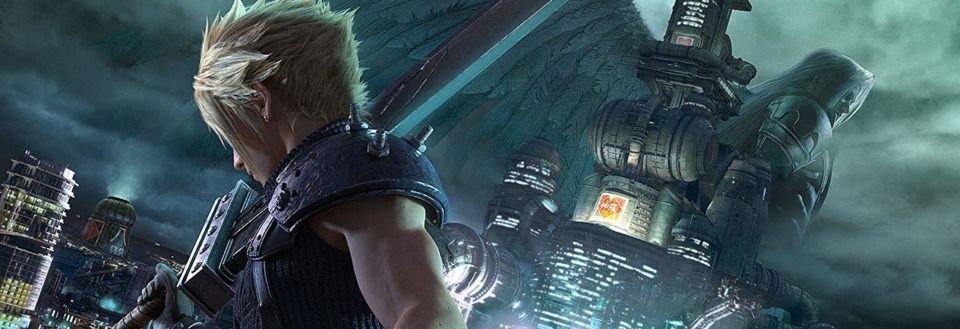Cities And Flower Girls - Some Scattered Thoughts On Final Fantasy VII Remake
By danielkempster 5 Comments
I like Final Fantasy VII.

To be honest, that statement probably goes without saying. FFVII played an integral part in how I earned my blogging crust on this website all those years ago, with my Enduring Final Fantasy VII series representing the biggest commitment I've made to any writing project I've ever pursued. That series, an epic undertaking that spanned thirty-five entries across almost four years, served as a deconstruction of what I love about Squaresoft's ground-breaking PS1 RPG, while trying to ascertain whether the game still has anything to offer a contemporary audience (my conclusion, in case you're wondering, is that it absolutely does). Consequently, the game has become inextricably tied to my presence on Giant Bomb. Hence, it will likely come as a surprise to no one that I'm currently playing through Final Fantasy VII Remake in my spare time.
I'm currently about twenty hours into FFVII Remake and have just started Chapter 10 (no spoilers for anything beyond the Wall Market sequence, please!). I'm deliberately going slowly, trying to play no more than an hour a day on average and savouring the experience in a way I don't often attempt with video games any more. Most of that time has been enjoyable. I'm not here to dissect the experience or pass judgement on the game as a whole, especially not when I still have (by all accounts) about half of its content left to experience. I will say that I really like the pseudo-turn-based combat mechanics and the additional layer of strategy and tactical depth they provide on top of the (largely intact) Materia system from the original game. I'm a bit torn on the changes made to the story thus far, with some additions (like the ones involving Biggs, Wedge and Jessie) feeling like justified bits of character building and others (like the mysterious Whispers) feeling tacked-on and unnecessary, but I'm trying to keep an open mind and am at least willing to stay on the ride and see where the rest of the journey leads.
What I want to talk about today are two things that have struck me as I've played through the first half of Final Fantasy VII Remake. The first of those things is the game's portrayal of Midgar. The second is its portrayal of Aerith. One of them I really like, and the other has me feeling a little conflicted. I'll leave you to guess which is which while I prepare the banner for the next section of this blog. I suppose this would also be a good opportunity to warn you all that while I won't be discussing any story events in great detail, some of the comments below may tip-toe into mild spoiler territory for anyone wishing to go into FFVII Remake completely fresh.
A Tale of Two Cities

Final Fantasy VII Remake's rendition of the city of Midgar is astounding, of that there can be no doubt. It takes familiar places that have up until now existed only on a two-dimensional plane, and turns them into fully-navigable, three-dimensional environments. This augmentation is a powerful trigger for nostalgia, and is something that is noticeable right from the start of the game, with its retelling of the Sector 1 Mako reactor bombing mission synchronising almost perfectly with the opening of the original FFVII. The feeling of familiarity that this nostalgia elicits is then replaced with a child-like sense of wonder at the realisation that you can control the camera and experience these familiar places in a way that just wasn't possible previously.
This is to say nothing of the sense of scale that FFVII Remake manages to convey in its portrayal of Midgar. The first time this hit me was at the start of the game's third chapter, when Cloud disembarks the train in the Sector 7 slums with the rest of Avalanche. This is the first time the player is put in a position of control while under the plate, and my personal instinct was to immediately tilt the camera upward. Thankfully, I was not disappointed - the slums' skybox is dominated by the imposing darkness of the Sector 7 plate's underside, one of seven twisted masses of metal emerging from the city's central pillar that blot out almost all natural light. In the original game, we're told this plate is there, but due to technical limitations and the pre-rendered nature of the backgrounds, there are very few situations in which we're actually able to see it. In FFVII Remake, the plate above is a permanent imposition on the skyline, making it impossible to forget about its presence. This, in turn, feeds into the game's narrative by visually reinforcing the disparity between the "haves" up on the plate, and the "have-nots" in the slums below. Being able to see the plate so prominently at all times makes me feel the oppression that Avalanche are fighting against more acutely than I ever have while playing the original FFVII.
There is a feeling of unity to FFVII Remake's Midgar as well, a sense that this is indeed one giant city and not a mish-mash of maps joined by invisible corridors at each end. This is a problem evident in parts of the original FFVII, with pre-rendered backdrops often not syncing up directly with each other and leaving the player's mind to fill in the gaps in the journey that exist between the screens. Actually, it's probably unfair to call this a 'problem', since there's nothing inherently wrong with this approach. What I'm trying to articulate is that by modelling whole sections of Midgar that the player can navigate seamlessly, FFVII Remake cultivates the feeling of it being one big interconnected place. Based on the experience of playing through Chapters 8 and 9, I'm pretty sure it would be possible to travel from Aerith's church through the Sector 5 slums, via Wall Market, right through to the Sector 7 gate next to the children's park in Sector 6, and perhaps even beyond, all without ever encountering a loading screen or fade-to-black. Compare that to the original game, where you'd have to navigate about a dozen different individual screens and the transitions between them, and hopefully you'll see what I'm trying to get at.
Why then, if I am so ready to praise FFVII Remake's version of Midgar, do I still hesitate to brand it definitively superior to its pre-rendered PS1 counterpart? I think a big part of it is down to the game's wildly varying visual fidelity, something that has been the subject of much discussion since the game's release. In case you're not aware, Final Fantasy VII Remake's environments are filled with a lot of low-poly, poorly-textured objects hardly befitting a late-generation PS4 release. This is not an uncommon phenomenon with modern games, and the discourse around it is often hyperbolic, with comments comparing visuals to those from the PS2/Xbox/GameCube era. However, having witnessed FFVII Remake's graphical inconsistencies myself, it's difficult not to agree in this instance. For every gorgeous skybox or lovingly hand-crafted shop sign, there is a hexagonal medicine bottle or an apartment door seemingly devoid of textures. These discrepancies are made even more immersion-breaking by the presence of Cloud and his companions' exquisitely-detailed, wonderfully-animated character models, which seem almost out-of-place against the seemingly half-finished backdrops they explore.
Compare this to the original Final Fantasy VII and the situation is almost wholly reversed. FFVII is universally derided for its blocky overworld character models, but its static, pre-rendered environments are filled with little details that still impress me today and serve to make the world feel vibrant and alive. This high level of environmental detail is what I believe makes Midgar such a memorable location for those of us who first played FFVII all those years ago, essentially portraying the city as a character in its own right. Crucially, the quality of the presentation across Midgar's scores of pre-rendered backdrops is consistent, preserving a sense of place without ever questioning the player's suspension of disbelief or breaking their immersion. FFVII Remake may better nail the city's size and scale, but the fact it doesn't hold up to close scrutiny means it doesn't quite surpass its source material for me.
Not a Delicate Flower

One area in which Final Fantasy VII Remake absolutely does exceed my expectations, though (at least up to the start of Chapter 10), is in its portrayal of Aerith Gainsborough. I'll be honest, one of my primary concerns going into the game was how it was going to handle its main cast. Through the Compilation of Final Fantasy VII and the Kingdom Hearts series, Tetsuya Nomura has demonstrated a worrying lack of awareness of who the characters he designs are supposed to be, and given his position as director of FFVII Remake, I was expecting that trend to continue. While most of FFVII's cast have suffered at his hands over the last two decades, I'd argue none have been warped beyond recognition to the extent that Aerith has. In almost all media post-FFVII, the flower girl from the slums has been portrayed as a pseudo-messianic figure - pure, chaste, her presence almost ethereal (literally ethereal, in the case of Advent Children). She smiles, she speaks softly, all the while seeming almost passive and subservient to the likes of Cloud and Zack.
If you've played Final Fantasy VII, you know this isn't Aerith. Aerith isn't a holier-than-thou embodiment of purity. She is cheeky, she breaks the rules, she answers back, and she's not afraid to call people out when they're being unreasonable. Aerith is also (for lack of a better word) spunky. She has a positive outlook on almost every situation, and that radiates outward as a positive influence on the people around her. While she does rely on Cloud to protect her early on, she's far from the archetypal damsel in distress, giving the impression that it's lack of experience rather than lack of ability that prevents her from holding her own against the likes of Reno and Rude. Later, she turns that archetype completely on its head by masterminding the plan to get into Don Corneo's mansion and rescue Tifa, all through cunning and ingenuity rather than sheer brute force.
Final Fantasy VII Remake gets this, it gets all this, and I honestly couldn't be happier. The last two chapters of the game have been my favourite parts to date, and a lot of that is down to spending them in the company of Aerith, getting to know her, and seeing her behave in a way befitting her, rather than some bastardised version of the character. This is epitomised in the scene from Chapter 8 where Cloud and Aerith escape from Reno at the church by fleeing across the rooftops. The pace of the game slows down very deliberately here, and there are no combat encounters. It's just Cloud and Aerith, carefully navigating the rooftops and getting to know each other as they do. Aerith is utterly adorable in this scene, gently poking fun at Cloud while also trying not to seem completely incompetent as she picks a route through the rusty scrap with him. It's so endearing to watch unfold and might be my favourite bit of character interaction in the game so far.
This is just one scene, to say nothing of the sequences that follow. Going to her house and meeting her mother Elmyra, exploring the Sector 5 slums and doing odd jobs together for the residents of the undercity, the entire reimagined Wall Market sequence - it has all been memorable, and Aerith has been instrumental in that. I may be misremembering this, as I haven't been able to find a source, but I have a vague recollection of reading something online, potentially an interview with Hironobu Sakaguchi, stating that Aerith's name is supposed to reflect the fact that she comes into Cloud's life like a breath of fresh air. That could be completely wrong, but that's how I've always interpreted it myself, and this incarnation of Aerith is the epitome of that idea. I honestly can't wait to spend more time with this character through the back half of Final Fantasy VII Remake, and into whatever comes next.
---
That's going to do it for this blog. I'd be very interested to hear other players' thoughts on how the remake handles both Midgar and its returning characters (providing they avoid spoilers post-Chapter 9!). Perhaps one day in the far-flung future, when the Final Fantasy VII Remake project is complete, I'll be able to attempt a serial blog dissecting it and comparing it to its inspiration. Until then, I hope this little snippet will suffice. Thanks very much for reading folks. Take care, and I'll see you around.
Daniel
---
Currently playing - Final Fantasy VII Remake (PS4)

5 Comments